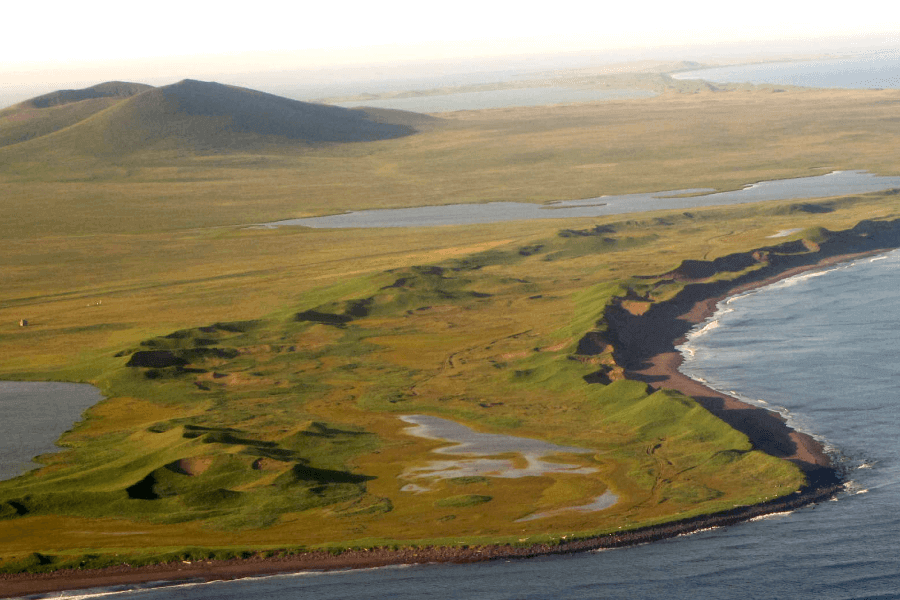TUTOR:
So, Rosie and Martin, let’s look at what you’ve got for your presentation on woolly mammoths.
ROSIE:
OK, we’ve got a short outline here.
TUTOR:
Thanks. So it’s about a research project in North America?
MARTIN:
Yes. But we thought we needed something general about woolly mammoths in our introduction, to establish that they were related to our modern elephant, and they lived thousands of years ago in the last ice age.
ROSIE:
Maybe we could show a video clip of a cartoon about mammoths. But that’d be a bit childish. Or we could have a diagram, it could be a timeline to show when they lived, with illustrations?
MARTIN:
Or we could just show a drawing of them walking in the ice? No, let’s go with your last suggestion.
TUTOR:
Good. Then you’re describing the discovery of the mammoth tooth on St Paul’s Island in Alaska, and why it was significant.
ROSIE:
Yes. The tooth was found by a man called Russell Graham. He picked it up from under a rock in a cave. He knew it was special – for a start it was in really good condition, as if it had been just extracted from the animal’s jawbone. Anyway, they found it was 6,500 years old.
TUTOR:
So why was that significant?
ROSIE:
Well the mammoth bones previously found on the North American mainland were much less recent than that. So this was really amazing.
MARTIN:
Then we’re making an animated diagram to show the geography of the area in prehistoric times. So originally, St Paul’s Island wasn’t an island, it was connected to the mainland, and mammoths and other animals like bears were able to roam around the whole area.
ROSIE:
Then the climate warmed up and the sea level began to rise, and the island got cut off from the mainland. So those mammoths on the island couldn’t escape; they had to stay on the island.
MARTIN:
And in fact the species survived there for thousands of years after they’d become extinct on the mainland.
TUTOR:
So why do you think they died out on the mainland?
MARTIN:
Anyway, next we’ll explain how Graham and his team identified the date when the mammoths became extinct on the island. They concluded that the extinction happened 5,600 years ago, which is a very precise time for a prehistoric extinction. It’s based on samples they took from mud at the bottom of a lake on the island.
MARTIN:
They analysed it to find out what had fallen in over time – bits of plants, volcanic ash and even DNA from the mammoths themselves. It’s standard procedure, but it took nearly two years to do.
TUTOR:
So why don’t you quickly go through the main sections of your presentation and discuss what action’s needed for each part?
MARTIN:
OK. So for the introduction, we’re using a visual, so once we’ve prepared that we’re done.
ROSIE:
I’m not sure. I think we need to write down all the ideas we want to include here, not just rely on memory. How we begin the presentation is so important …
MARTIN:
The discovery of the mammoth tooth is probably the most dramatic part, but we don’t have that much information, only what we got from the online article. I thought maybe we could get in touch with the researcher who led the team and ask him to tell us a bit more.
MARTIN:
Great idea. What about the section with the initial questions asked by the researchers? We’ve got a lot on that but we need to make it interesting.
ROSIE:
We could ask the audience to suggest some questions about it and then see how many of them we can answer. I don’t think it would take too long.
TUTOR:
Yes that would add a bit of variety.
MARTIN:
Then the section on further research carried out on the island – analysing the mud in the lake. I wonder if we’ve actually got too much information here, should we cut some?
ROSIE:
I don’t think so, but it’s all a bit muddled at present.
MARTIN:
Yes, maybe it would be better if it followed a chronological pattern.
ROSIE:
I think so. The findings and possible explanations section is just about ready, but we need to practice it so we’re sure it won’t overrun.
MARTIN:
I think it should be OK, but yes, let’s make sure.
TUTOR:
In the last section, relevance to the present day, you’ve got some good ideas but this is where you need to move away from the ideas of others and give your own viewpoint.
MARTIN:
OK, we’ll think about that. Now shall we …
 Sau khi nghe "about woolly mammoths in our introduction" là biết đáp án chuẩn bị vào.
Sau khi nghe "about woolly mammoths in our introduction" là biết đáp án chuẩn bị vào. Nhiều bạn khi nghe "Maybe we could show a video clip of a cartoon about mammoths." thì chọn đáp án C(with a video clip about woolly mammoths)
Nhiều bạn khi nghe "Maybe we could show a video clip of a cartoon about mammoths." thì chọn đáp án C(with a video clip about woolly mammoths)  Sau đó nghe "Or we could have a diagram, it could be a timeline to show when they lived, with illustrations"
Sau đó nghe "Or we could have a diagram, it could be a timeline to show when they lived, with illustrations" 

